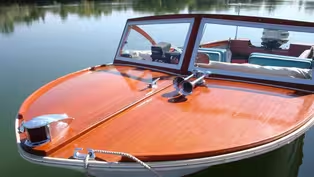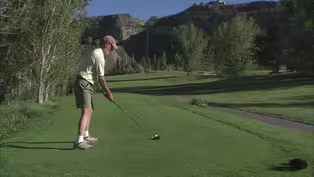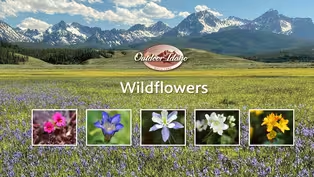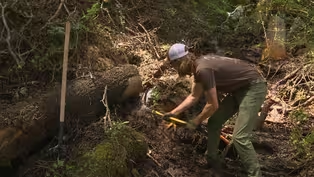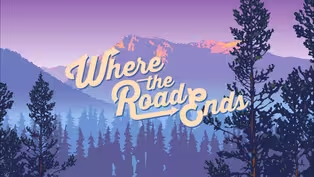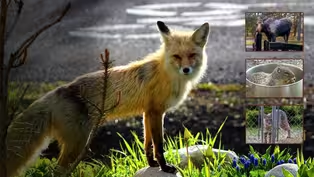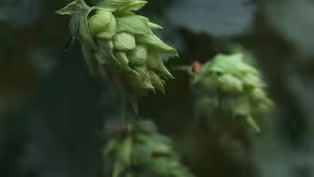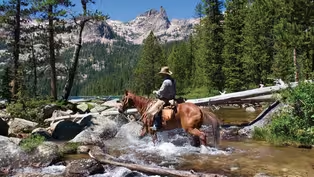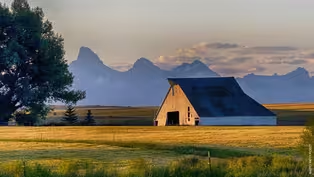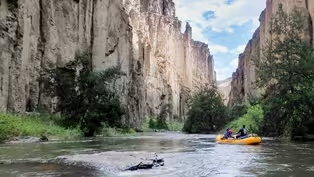
Off the Beaten Path
Season 38 Episode 6 | 26m 49sVideo has Closed Captions
Outdoor Idaho goes “Off the Beaten Path” to find places of wonder and delight.
From a desert river canyon to a towering tree oasis, Outdoor Idaho explores the lesser known landscapes of our uniquely shaped state, through the eyes of people who know the regions well.
Problems playing video? | Closed Captioning Feedback
Problems playing video? | Closed Captioning Feedback
Outdoor Idaho is a local public television program presented by IdahoPTV
Major Funding by the Laura Moore Cunningham Foundation. Additional Funding by the Friends of Idaho Public Television and the Corporation for Public Broadcasting.

Off the Beaten Path
Season 38 Episode 6 | 26m 49sVideo has Closed Captions
From a desert river canyon to a towering tree oasis, Outdoor Idaho explores the lesser known landscapes of our uniquely shaped state, through the eyes of people who know the regions well.
Problems playing video? | Closed Captioning Feedback
How to Watch Outdoor Idaho
Outdoor Idaho is available to stream on pbs.org and the free PBS App, available on iPhone, Apple TV, Android TV, Android smartphones, Amazon Fire TV, Amazon Fire Tablet, Roku, Samsung Smart TV, and Vizio.
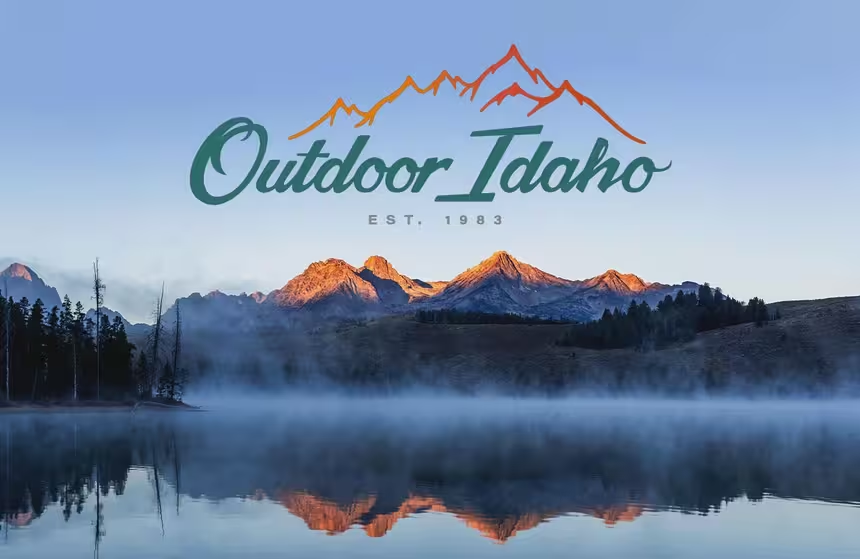
Outdoor Idaho on YouTube
Can't get enough Outdoor Idaho? Neither can we. Subscribe to the Outdoor Idaho YouTube channel for even more great content. You'll find full episodes, sneak peeks, behind-the-scenes footage, and exclusive content you won't find anywhere else. Subscribe today!Providing Support for PBS.org
Learn Moreabout PBS online sponsorshipMore from This Collection
Idaho Entire
Video has Closed Captions
Features highlights from several wooden-boat shows on beautiful lakes in Idaho. (26m 48s)
Video has Closed Captions
Outdoor Idaho visits some of its not so famous courses in different regions of the state. (26m 48s)
Video has Closed Captions
Outdoor Idaho is telling the stories behind the colorful wildflowers that dot our state. (26m 47s)
Video has Closed Captions
Meet the volunteers doing trail work on Idaho's public land. (26m 48s)
Video has Closed Captions
We explore some unique, out of the way places, where the road ends. (26m 47s)
Video has Closed Captions
Outdoor Idaho is exploring the relationship between humans and urban wildlife in Idaho. (26m 46s)
Video has Closed Captions
We explore the relationship between hops, barley and Idahoans who make and drink beer. (26m 49s)
Video has Closed Captions
Idaho’s many scenic byways provide a fascinating way to see the best parts of the state. (26m 46s)
Video has Closed Captions
We examine some of the changes in Idaho in the past 30 years. (56m 53s)
Video has Closed Captions
Outdoor Idaho seeks out some of our state’s majestic agricultural icons. (56m 46s)
Video has Closed Captions
Outdoor Idaho goes “Off the Beaten Path” to find places of wonder and delight. (56m 53s)
Video has Closed Captions
We visit Idaho's Wilderness areas to discover what we've learned. (26m 47s)
Providing Support for PBS.org
Learn Moreabout PBS online sponsorshipBRUCE REICHERT, HOST: We've all seen those iconic Idaho images that fill the travel brochures, the ones that are decidedly Idaho.
But what about the places that aren't so readily accessible, that require some effort on our part to get to, that demand a willingness to wander far from the crowds and the cares of the everyday world.
REICHERT: From the green cedars up north to the frigid landscapes in the east, Idaho is ripe with color and with character.
There's good reason to take the trail less traveled.
The truth is, all who wander are not necessarily lost.
Perhaps, they're seeking something more, be it solitude, adventure, or simply traveling someplace new.
It's in our pursuit of wonder that we find ourselves taking that first step, off the beaten path.
Funding for Outdoor Idaho is made possible by the Laura Moore Cunningham Foundation, committed to fulfilling the Moore and Bettis family legacy of building the great state of Idaho.
By the Friends of Idaho Public Television, by the Corporation for Public Broadcasting.
REICHERT: These charming rock formations are a product of tiny limestone pebbles called oolites that fused together.
It's the result of a 6 million year old fresh-water lake that geologists call Lake Idaho.
Seems everywhere these days, you can find places that inspire and befuddle.
Hi I'm Bruce Reichert and welcome to Outdoor Idaho.
You know, I think it's safe to say that this state joined the union of states early because people were willing to get off the beaten path, in search of gold, pelts, timber, farmland.
And they were all desperate for a better life.
Today there's not quite that desperation to get off the beaten path and into the wild; today it has more to do with, well, relaxation, or the desire to explore.
Or maybe to preserve one's sanity.
JEAN MCCABE, PSYCHOLOGIST: Nature tends to keep us focused in the present moment.
And that is so healthy and that is a philosophy we've known for centuries is a key to mental health is not focusing on the future, which is usually worrying or focusing on the past, which is, keeps us depressed.
So staying in the present, which nature allows us to do and encourage us to do is, is truly very, very good.
REICHERT: Have you ever looked at something so darn pretty, you had to wonder if it was real?
Right out of a postcard, or a movie set.
The views from a yellow raft floating down the Bruneau River at the bottom of this impenetrable canyon will inspire such wondrous considerations.
BARKER: I have guided a little bit all over the world and man, I come back here on the Bruneau and it's like, this really is one of the most amazing river canyons in the world.
It holds up to, to anywhere.
I do have to say my favorite rivers in Idaho are all the desert rivers.
SHANE MOSER, RAFT GUIDE: When you float the river, you get to see the change from the top to the bottom and you see everything in between.
And that's pretty unique.
REICHERT: The Bruneau River flows north through the Owyhee Canyonlands, formed by the Jarbidge River, out of the mountains in northern Nevada.
Spring runoff, transformed into a boater's playground.
MOSER: You've got the flowing walls fast, current, you know, there's not a lot of, eddy's, kind of boiley water, brown water, you know, the Bruneau is a French word for brown water.
REICHERT: About 40 miles of the Bruneau is federally protected as a wild river, and wild it is, weaving its way a thousand feet below the canyon rim.
Despite being a desert river, in a desert canyon, the banks of the Bruneau are anything but barren.
MOSER: It's its own kind of desert jungle down here.
There's, you know, thick junipers and, and poison ivy, that's eight feet tall, and a wild rose and all the classic kind of shrubs too, you know, there's service berry and choke cherry and syringa, and when the choke cherries are blooming, it's, you know, smells sweet.
REICHERT: Mysteries abound among the basalt walls and rhyolite spires, with massive caves hidden deep in the canyon.
BARKER: It just feels extra special.
When you're here, you know, that it took extra effort to come down here and you're somewhere that you're not going to get to do all the time.
And it's just a stunning, gorge, its amazing geology, geography, the riverbed, the rapids.
I think the most common reaction from folks coming down the river is kind of a, more of a silent awe, you know, it's, it's a place that promotes some solitude and quietness and people are just looking around going, am I really here?
I didn't know there could be somewhere quite like this.
REICHERT: As the canyon widens, opening into pastures and dirt roads, the reality of real life begins to seep back in.
A reality that for a few days was set aside, allowing for the magic of a picture-perfect river canyon to capture imagination.
In another era, this unbeaten path was very much beaten.
Idaho's Curlew National Grassland.
MATT LUCIA, SAGEBRUSH STEPPE LAND TRUST: Most of what is now the grassland were privately owned at one time and were farmed and ranched.
And this part of the world, this part of the state did see the same effects that we saw in Oklahoma and some of the other Kansas and the other dustbowl states.
It hit here too.
REICHERT: Years ago, this land had a ranch every 160 acres, thanks to partnerships between federal and state agencies along with the cooperation of private landowners, it's now comprised of 47,000 acres of public land.
LUCIA: Most of the restoration has been in the form of management changes and not hitting that the land is hard as it, as it once was.
So over the course of the last 50 or 60, 70 years, that grassland has come back.
Restoration of creeks in this system is a very active.
Reshaping the slope of the banks.
Stream restoration in arid landscapes is the key to land health and restoration.
It defines southeastern Idaho, the agricultural side of things, the wildlife side of things, this is it, this is Southeast Idaho to me.
REICHERT: Now if the words, "Curlew National Grassland," are new to your ears, you wouldn't be alone.
The Curlew is the only designated grassland in Idaho, and just one of 20 in the entire nation.
LUCIA: It's interesting that not a lot of people know about it.
The landscape itself is different than a lot of public lands administered by the Forest Service where you typically think of higher elevation.
The grassland itself is in the foothills of the lower valleys.
REICHERT: Comprised largely of sage brush and as you can hear home to lots and lots of birds.
LUCIA: It's pretty remarkable, the diversity of species and the numbers of them.
You don't expect to see shorebirds out in the middle of a grassland or in the middle of a, sagebrush habitat, but where there's water, there's wildlife.
REICHERT: And where there's wildlife, there's something worth watching.
LUCIA: And that's the beautiful thing about the Curlew is it provides a lot of opportunities to explore, take your binoculars, your bird book, your plant identification book, and see what it's all about.
And having that feel of solitude, you can find that just about anywhere you go in the Curlew, it's not used a ton and by the public.
And so, it provides a lot of opportunities to explore it.
REICHERT: In the far north of our state, a granite spire juts from the ground like a monument to the gods, a natural beacon.
KATIE LUTHY, CLIMBER: There's this big rock and you take this massive hike up the hill and then there's just this big feature that's sticks up and that you can see from a lot of different places.
STEVE REYNOLDS, CLIMBER: It's such an iconic feature for our region.
Anybody who travels up here, they can see it from a distance.
It's been carved out by three glaciers on each of its three different sides, the east, the west and the north sides that gives it that chimney appearance.
JASON LUTHY, CLIMBER: It's obvious as you drive up the road and you see Chimney Rock, it's kind of, oh, what is that thing?
Can I get to the top of it?
And it's got some lore within the climbing community.
KATIE LUTHY: It does take some commitment to get here.
Like it's a, it's a six, six and a half mile walk in.
And it's a pretty mellow trail to start and then it kind of climbs up and starts getting up into steeper terrain.
Then you come up and you kind of pop up and see the feature at different points, which is always, always neat.
It's like, oh, that's where I'm going.
And it's just a reminder of why you're taking the walk.
JASON LUTHY: The ability to get to a summit only with ropes is rare.
There's a lot of mountains that you climb where you can walk around the backside and get to the top.
The fact that you have to use ropes to access it and have a certain level of knowledge holds people back from being able to get to the top.
And I think that keeps it unique.
REICHERT: Unique and hard.
KATIE LUTHY: It's a challenge.
It's exposed.
You never know kind of like where you're going and just like you're taking gear out and kind of moving around and so it's, it's definitely manageable, but you're climbing this big feature that like, you're just kind of hanging out in the middle of nowhere.
REYNOLDS: It requires total focus.
It's such a privilege to be able to be up here and do this and not have to worry about the responsibilities we have in everyday life.
So my focus is on when I'm climbing is on the climbing itself.
REICHERT: As it should be, the climb to the top of Chimney Rock is 250 feet up and requires multiple stops or "pitches" along the way, making it a long day of climbing, for even experienced folks.
REYNOLDS: Oh my, it's hard to put it into words.
We have this beautiful environment, this alpine environment that's so unique that we have the Idaho Selkirks, with the granite slabs and the views in all directions.
I never get tired of it.
It's incredibly beautiful.
KATIE LUTHY: You just get up and then you have this wide 360 view of kind of the whole area it's stunning.
And it just kinda like, whoa, cool.
I did this.
You want to give a high five and like, hey, cool, look what we've done.
JASON LUTHY: Pend Oreille and you can see Priest Lake on the other side, and then the Selkirk Crest all the way up to Canada.
It's just a gorgeous section of terrain.
REICHERT: But there's only so much time for admiration.
KATIE LUTHY: I think anytime you climb a big feature where there's a significant rappel that comes down and it's like, you're not done yet.
And so you can't spend too much time celebrating.
Cause the, the down is just as important as going up.
REICHERT: A big rock, that's really all it is.
But for those who summit this pile of granite, it's so much more than that.
REYNOLDS: As far as Chimney Rock goes, this has always been the iconic alpine climb.
And as far as I'm concerned, it's the ultimate of what climbing is in the inland northwest.
This is, this is for lack of a better word, the pinnacle of what climbing is about.
REICHERT: In the winter, in Island Park, you need a sled, the motor kind, for going off the beaten path.
ANN MARIE ANTHONY, SNOWMOBILER: Where we are right now is on the Henry's Fork of the Snake River.
Just below Big Springs.
The lower area is beautiful because you don't have any wind to deal with and the trails are always good."
REICHERT: Henry's Fork of the Snake River is dressed in soft, white powder around elevation 6,000.
The snow coated trees stand straight along the ribs of the river and the riding is easy.
ANTHONY: We have hundreds of miles of groomed trail which is always nice especially when you're older and you've got this ailment and that ailment and this back injury.
All the miles of groomed trail are awesome.
REICHERT: But climb higher, above 8,000 feet and those layers of soft white turn crusty, strained by severe conditions and fierce exposure, allowing humans limited time to wonder.
ANTHONY: You can get frostbite very easy.
I got frostbite riding home the other night on my cheeks so I have brand new skin on my cheeks.
Temperature drops 20 degrees when you get up on top easily, always.
REICHERT: The 'top' is two top.
A clearing on a ridgeline that looks like the top of the world with views of the Tetons, Yellowstone and Montana on a clear day, but clear is hard to come by.
ANTHONY: There's always a little bit of fog when you get up on there, but if the sun comes out there's nothing like it.
REICHERT: Two top is a weather beaten point of such high exposure, its few trees are at the mercy of Mother Nature on her worst day which is nearly every day in the winter.
ANTHONY: This time of year we get one storm after another and a lot of times its very socked in, but today we got a chance.
We had some really pretty sun for about an hour and it was awesome.
REICHERT: What stands sentry up here doesn't grow straight like down below.
It's crooked, leaning, crippled by the crush of one snowstorm after another, wind all the time and fog between flakes.
(music) ANTHONY: They are our ghost trees.
You only find them on the tops, you know, because that's where the wind and snow accumulates the most and makes those beautiful, beautiful trees.
Every one has a different shape and every one of them could be a relative of Casper, the friendly ghost, because they all take on that form of being a ghost.
And when you're up there there's nothing quite like those.
So many different shapes and so many different icicles coming off one side and the light that can shine through.
It's our number one attraction in the wintertime by far.
Everybody wants to see our ghost trees and see how beautiful it is.
I feel very fortunate to be able to live here.
CHRISTINE PLOURDE, ST. JOE RANGER DISTRICT: When I'm in the cedar grove, I feel much smaller and it puts things in context.
REICHERT: The Hobo Cedar Grove is not simply a roadside attraction.
PLOURDE: I get to just appreciate the sounds and smells and the subtle breeze and the ferns when I'm down here.
Yeah, it gives a different perspective.
REICHERT: If you give it time, the trees will turn you inwards, evoking undiscovered emotions and conjuring up feelings of wonder PLOURDE: It's pretty magical, to me the sense of beauty is beyond the visual, it's more of an experience to be in here and be surrounded by things that are ancient and timeless.
It has a very peaceful and protected feeling to it, which is very appealing, to get away from the busyness of everyday life.
REICHERT: The 240 acre grove is a secret garden of 500-year-old Western Red Cedars, preserved initially because of their tendency to fall apart on log drives, making them poor candidates for clear-cuts.
And preserved now by the U.S. Forest Service, with a mission to safeguard rare botanical habitats.
PLOURDE: I hope when people see the grove they are inspired to care for their public lands and you know protect special like this, because they're really unique to what we have in this part of the country.
The trees in this grove can live more than 1,000 years.
Even at 250 years old they can be up to 160 feet tall and 8 feet in diameter.
PLOURDE: So cedars are a climax species,0 which means that are shade tolerant, and they can basically out-compete other trees in this setting.
The reason this pocket has survived for so long is that it is in this wetter, cooler situation.
By nature of cedar trees they are really rot resistant and disease resistant so you know, without some natural disturbance such as wind or fire they could stand in perpetuity.
REICHERT: And in our unpredictable and impermanent lives, unchanging and perpetually standing trees serve as a big sigh of relief.
PLOURDE: It's very peaceful.
I don't know how else to describe it.
This is a special place, for solitude and reflection.
REICHERT: The Sawtooth Mountains, a range that needs no introduction.
It's perhaps the most photographed region of the state.
When the Sawtooth Wilderness boundaries were drawn in 1972, the Forest Service excluded a mining claim, the Greenback Mine and this jeep road to it.
The mine eventually proved unproductive, but mountain bikers can still ride several miles into this canyon on the old road, since it's not in official wilderness.
And that's something Hannah Fake likes to do.
But once she parks her bike, and prepares to climb, things get a lot harder.
That's because there's not much of a path and it's pretty much straight up.
HANNAH FAKE, NATURALIST: The first time I came up here, I remember stopping about every 10 feet.
Like this is so steep.
This is so hard.
REICHERT: As the lead naturalist at the Redfish Lake Visitor Center, Hannah has seen the best that the Sawtooths has to offer.
Part of her job is to offer suggest places where people can visit.
But, this is not one of those places.
FAKE: It is steep and loose and rocky and makes this place inaccessible to a lot of people, which is part of the reason why it's so quiet and beautiful.
And there's no one else up here.
This place is special.
I've been here more than I've been to most places in the Sawtooths.
I've had multiple trips here.
Coming up, I love getting off trail.
It's a hanging valley, so that's why that trail is so steep.
When you have hanging valleys, it collects water generally in lakes up above, and then just drops down in a falls.
It's all year round pouring water, which is pretty cool up here.
And you can really get pretty close to it and get some really nice views on that trail up.
And if you could continue to just a little bit further, you can find the lakes that feed it.
REICHERT: Just about every lake in the Sawtooth range is postcard perfect and the lakes above the falls are no exception.
I think almost always in the Sawtooths, the little higher you get the better reward it is.
The further you go out, the less people you find.
So the three different lakes and each one gets a little smaller as you go up and get a little better view looking out across the valley and the mountains.
FAKE: Once you get off trail, you hardly see anyone.
Just a quick scramble up from the trail and you're at these beautiful lakes where no one's around.
And off trail is definitely not for everyone, but that's some of my favorite places to go to hike to a peak or hike to a valley and know that you are the only person in that entire valley or drainage for the day or even the night is pretty special.
REICHERT: And in this wild world where sometimes it seems, every spot is taken, every trail trodden, it's good to remember that, there's are still places, to step off the beaten path.
ANNOUNCER: Funding for Outdoor Idaho is made possible by the Laura Moore Cunningham Foundation, committed to fulfilling the Moore and Bettis family legacy of building the great state of Idaho.
By the Friends of Idaho Public Television, by the Corporation for Public Broadcasting.
To find more information about these shows, visit us at IdahoPTV.Org.

- Science and Nature

Explore scientific discoveries on television's most acclaimed science documentary series.

- Science and Nature

Capturing the splendor of the natural world, from the African plains to the Antarctic ice.












Support for PBS provided by:
Outdoor Idaho is a local public television program presented by IdahoPTV
Major Funding by the Laura Moore Cunningham Foundation. Additional Funding by the Friends of Idaho Public Television and the Corporation for Public Broadcasting.
